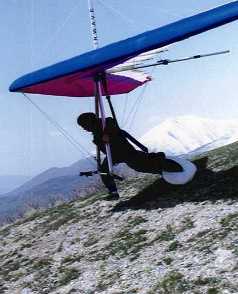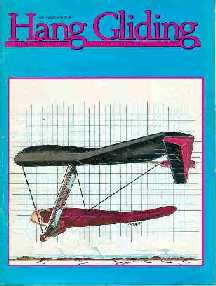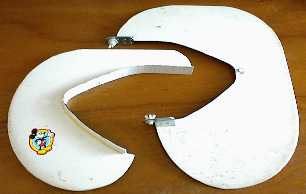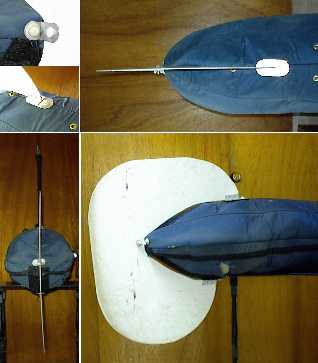The Pod Harness Yaw Neutralizer (PHYN)
© Jeff Roberson
Created: 2001-Jun-10
Edited: 2008-Sep-14
Revision History
Introduction

Occasionally while flying a hang glider, you must completely let go of the control bar to take care of some task that requires both hands (e.g. fiddling with zippers, opening containers, troubleshooting radio problems, etc). When you do let go, your glider continues to fly along pretty much A-OK for a while in accordance with its inherent stability. Meanwhile, your dangling hot-dog shaped body eventually starts to rotate and swing around aimlessly, twisting in the wind with your head bonking into various lower rigging glider parts. This happens because the airflow across the physical form of your body/harness provides virtually no yaw stability (i.e. the aerodynamic center of pressure (CP) is located very close to the center of gravity (CG)). Your harness stays aligned into the wind only if you deliberately make it so. Although this requires a bit of work, pilots have been flying this way since the beginning of time with no complaints heard thus far.
Twisting in the wind was getting to be rather annoying for me at times (especially when trying to take relief in extreme cold at high altitude on a rough, big-air day), so in the fall of 1995, I decided to build a tail fin to fix this problem. As was hoped for, the fin did indeed stop this twist-in-the-wind phenomenon. However, it turns out that it provides additional unexpected benefits as well, which I thought might be of interest to the pilot community at large. This article seeks to present the results of my harness tail fin experimentation.
Phlying
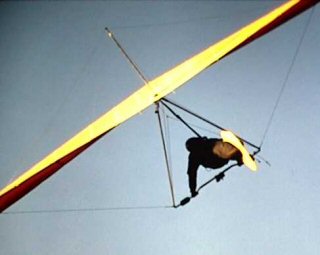
The stabilizing effect is notoriously subtle, but definitely there. It is weak at slow speed and strong when going fast. When you let go of the bar, it does keep your body pointed straight into the wind and does not affect the harness pitch behavior. Your body's trim position is a tad farther forward relative to the glider. You and your glider behave the same as before, so at first the phyn appears to serve no useful purpose. It turns out that after many years of flying the regular way, we develop muscle memory and strong habits that are very hard to break. Thus, when the phyn is first attached, it appears to do absolutely nothing because you continue to do all the work, just like you always have. I flew around like this for nearly three years before I discovered something very cool indeed.
It was a typical good Northside day in 1998 when, out of curiosity, I decided to see if the phyn would allow me to fly using just one hand. I tucked my left hand into my pants pocket to get it out of the way. Shortly thereafter, I experienced a major epiphany. Once I had let go the notion that I was responsible for keeping myself pointed straight into the wind at all times, I submitted and allowed the phyn to do its thing. At first, it was difficult to relinquish all yaw control inputs (several times, I was very tempted to grab on with both hands), but after a while I discovered that I could indeed fly using just one hand (actually just two fingers of one hand; thumb and forefinger). However, it required using a brand new method of turning!

YouTube videos showing one handed manuvering:
"Phyn Phlying..."
"More Phyn Phlying..."
Instead of translating your body sideways in the conventional manner using both hands, you simply rotate your body using just one hand to push your head in the direction you wish to go. Once your body gets a bit sideways, the wind starts acting on the phyn which pushes your tail in the direction required to straighten you out. Thus, the phyn can and will do work for you, but only if you let it. On this flight I flew for over an hour and a half with one hand, trading right and left every 20 minutes or so. This flight was a mixture of mellow thermals and ridge lift, and the VG of my PacAir K2-145 was 50% on.
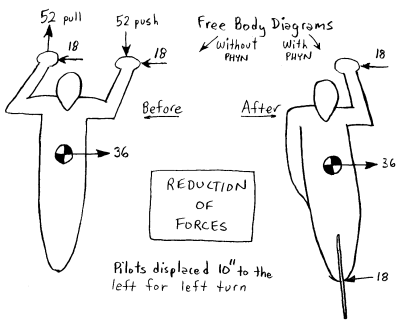
External forces acting on pilot with and without Phyn
It turns out that this new turning method is both natural and easy. Its natural, because you simply rotate your upper body to point your head in the direction you wish to go. It makes flying easier because there is no longer a need to spend as much energy keeping your body pointed in the wind (this workload is significant and you really only notice it once its gone. For more, see my (rough) handwritten notes). And the stabilizing effect of the phyn makes it easier to relax while flying since you can significantly lighten up your grip on the bar. This also makes it easier to fly twitchy gliders that are very sensitive to control inputs (such as my K2). Once your grip is more relaxed, you can better sense what you and your glider are doing.
The phyn provides enhanced yaw control authority and allows you to apply a continuous yaw force to the control bar (something you couldn't do otherwise). You're feet are now "connected" to the air, giving you something solid to push against in the yaw direction. Without a phyn, the only thing you can "push against" is the rotational inertia of your body (i.e. the so called "punch turn"), which only works for a brief moment.
Drag Considerations and Practicality
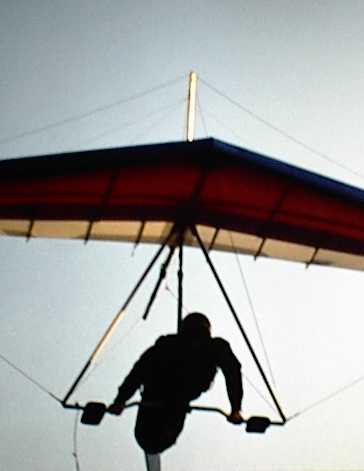
The obvious first concern for most pilots is added drag. All else being equal, if two identical pilots are flying along side by side, one wearing a phyn and one not, the one wearing the phyn will likely generate more drag. However, if the phyn pilot tucks one arm to one's side out of the airflow, and holds onto the center of the base tube with the other, it is quite possible and that a net drag reduction may result. When aligned into the wind, the exposed frontal area of the PHYN-II is less that 3 square inches, whereas the frontal area of an arm is at least 30 square inches. And although the phyn has quite a few square feet of exposed area, almost all of this area is subject to parasitic skin friction drag only, which is very small for PVC plastic. This one hand style could be employed during glides between thermals since the phyn is quite effective at higher speeds. When thermalling, the small amount of drag generated is not so much a concern. In fact, the extra yaw authority assists the pilot to fight the rising wing when pursuing a strong thermal core, and thus allows for faster centering.
And consider this. When you fly without a phyn, there is no real feedback to tell you when your body is misaligned. On several occasions before building the phyn, I flew with a video camera attached to the aft end of the keel looking forward. Upon reviewing these tapes, I discovered that frequently while thermalling, my body was not only rocked up, but was turned sideways to the wind at a fairly large angle (I was sort of "standing up", which is a very natural position). Flying with the phyn has helped me to correct this draggy behavior since it is always nudging me back into the wind (although I still rock up for comfort when thermalling). A pilot flying with a phyn aligned into the wind will generate much less drag than a pilot flying "sideways" without one. Thus, the phyn not only lets you know when you are misaligned, it continuously provides a force to get you realigned.
Realistically, turning with the one-handed technique described above is only feasible in mellow conditions since you really need both hands in big air. And turning in this manner is more sluggish and "draggy" than the conventional way, and doesn't work well at speeds near minimum sink (especially with higher VG settings). I have found that a combination of the old and the new is best for all around use. Letting the phyn do some of the work allows you to lighten your grip and relax, which in turn enables you to better sense what your glider and the surrounding air is doing. Personally, I really like flying the phyn and will continue to do so until something better comes along.
Future Enhancements

The purpose of this article is to stimulate others to undertake further research. Wind tunnel tests, computer model simulations and/or competition trials could deterministically find out if drag reduction is actually achieved when flying with one arm in a speed-skater-like manner. The phyn presented in this article is but a crude prototype designed to test a principle. Future phyn designs can easily improve on my primitive prototypes. Here's a few ideas:
- The optimal design (i.e. size, shape, materials, etc) needs to be determined.
- A hollow, airfoil cross section made with advanced materials would improve the fin's effectiveness while reducing both weight and drag. (injected molded plastic? Graphite?, Kevlar?)
- A clean, simple, trick, quick-attach mechanism would make setup a snap. (plastic PIP pins?)
- Converting the passive harness fin to an active rudder could give the pilot's feet something truly useful to do.
- A spring loaded split-fin clamshell arrangement could provide spoiler functionality similar to sailplane dive brakes.
The Pros and Cons
The Pros:
- Less drag. (when flying fast with one arm streamlined against body?)
- Provides pilot with ability to accurately sense yaw.
- Provides enhanced yaw control authority.
- Reduces workload by continuously pointing pilot directly into the relative wind.
- Provides a new way of turning which requires only one hand.
- Improves your visibility to other pilots.
- Provides skid protection for fabric harness tail.
- Something to decorate with bumper stickers.
- Easily fits in harness bag with rest of gear.
The Cons:
- More drag. (however, this is useful drag)
- More weight.
- One more component that can go wrong.
- One more item to fiddle with before and after flight.
- On the ground, the phyn tends to flatten out horizontally, which twists the harness tail 90 degrees.
- Could conceivably catch between slats of a launch ramp.
- Could conceivably catch on parts of towing dolly.
- Looks goofy.
The Experimental Design
Note: This harness tail fin idea is not new. In fact, the October 1984 HG mag had a futuristic concept glider on the cover with a pilot sporting a harness with a fin. And in late '95, Harry Martin's comic strip featured the topic, clearly illustrating a shark-like tail fin. I'm sure others have toyed with the idea over the years. Hanging out with the buds after a day's flying with the first prototype, a seemingly appropriate name for this contraption just popped out: The Pod Harness Yaw Neutralizer, or PHYN.
REQUIREMENTS: The device must be safe, simple and effective. It must be built tough to last long (life is brutal at the tail end of your harness!) and the design must be fail-safe. RAW MATERIAL: I had been tossing around several elaborate fabric/tent-pole design ideas for several weeks when my buddy Ray ("Kid Comet") suggested using a piece of plastic sheet. Voilà! For an experimental prototype, this material seemed perfect: cheap, strong, durable and a very low drag coefficient. SHAPE: From a safety perspective, it must not have any sharp points or edges. A round shape seems safest and is unlikely to catch or dig into the ground when you need to back up while hooked in. To evenly distribute and transfer the in-flight loads (and prevent bending), the fin's center of area should occur inside the attachment area forward of the tip of the harness' tail. SIZE: Who knows? But the first prototype should probably err on the small size to be safe. A couple of square feet seems about right. FABRICATION: stuff the harness tail with pillows to simulate its shape in flight, hang the harness in front of the plastic sheet, shine a light from some distance to cast a shadow of the harness tail onto the sheet, trace out the outline of the shadow onto the sheet, trace out the remaining outline defining the fin's shape then cut it out and smooth the edges. HARNESS MODS: The fin weighs about two pounds and is located at the extreme aft-end, so the adjustable CG system must have enough free rearward travel to allow the harness to balance when proned out. ATTACHMENT: So how does one safely attach a pointy edged thin slab of plastic to the harness? It should be able to break away in an emergency. And it should be designed so that it is virtually impossible for the device to catch on your rear wires.
The first prototype, the PHYN-I, utilizes a protective strip of plastic which covers the sharp inside edges and provides surface area to allow attachment to the harness using Velcro. In the field, the Velcro didn't work out as planned so the PHYN-I ended up being attached to the harness with the assistance of duct tape (which proved to be quite a hassle). During flight, this first phyn worked OK, but its effect was weak. The next prototype needed to be bigger. The second prototype incorporates twice the area and a simplified three point aluminum bracket nylon bolt attachment (see photos).
The PHYN-I had its maiden voyage on September 24, 1995 and the PHYN-II on April 19, 1997, both at the Northside Point of the Mountain (Draper, Utah). The first prototype was a pain to attach and remove so I did not fly with it religiously. However, the second prototype proved to be quite convenient, so I have flown with it pretty much every flight since the first day. As of May 2001, I have logged 130 hours with the PHYN-II. It fits quite nicely in my standard harness bag and adds about 2 minutes each, to the setup and teardown process.
Summary
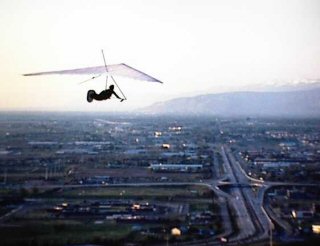
The Pod Harness Yaw Neutralizer, or PHYN, is a passive vertical aerodynamic surface that is attached to the aft end of a hang glider harness, which provides significant yaw stability to the pilot component of the aircraft system during flight. When flying with this device, you effectively becomes a human yaw string and are better able to sense the relative wind (i.e. slips and skids or lack thereof). When you relax your grip on the control bar (both mentally and physically), and allow the phyn to do its thing, it tends to keep you aligned directly into the relative wind at all times. When you relax even more and start thinking of the phyn as an extension to your own body, you discover that you are now able to roll control your glider using an entirely new technique. This new technique allows you to fly using just two fingers of one hand (at speeds above minimum sink in not-too-rough air). And it seems reasonable that a skilled pilot (desperate for glide point improvement) could control the glider with one hand and hold the opposite arm flush against the side of the body in a streamlined manner (like a speed skater), to reduce overall drag when gliding between thermals.
About the author:
Jeff has been actively flying hang gliders primarily in Utah since 1981 and has more that 1300 logged hours. Received his BS in Civil and Environmental Engineering in 1981 and worked for 15 years since then as a software and testing engineer. He administered the "Utah Cup" cross country competition 9 years for the Utah Hang Gliding and Paragliding Association. An avid XC pilot, he currently holds 3 Utah site distance records.
